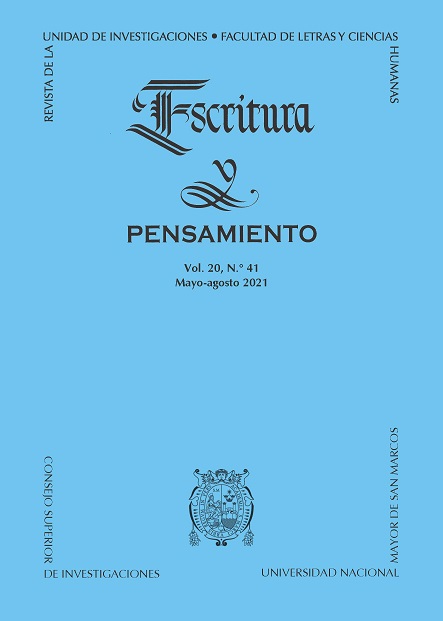Narrating the border: Edges of a gender in displacement
DOI:
https://doi.org/10.15381/escrypensam.v20i41.21121Keywords:
border story, migration, memoryAbstract
The article discusses gender problems in the border story and its relationship with the travel story based on the phenomenon of Latino migrant displacement from the voice of an undocumented woman. It is interesting to inquire about the boundaries that are drawn within the story in relation to its generic borders, while reflecting on the ways of making memory and its writing. The text, a device for the preservation and elaboration of memory, is a collective record of those who travel the northern border. The text is a pedagogical act of struggle and resistance in favor of life, since it offers a self-consciousness of unity of the vital and historical experience of the marginalized. Its intentionality is transformative of existence since it rehearses a way of resisting and (re) building a rift where the present history and the historical memory of the displaced flourish.
References
Alburquerque-García, L. (2011). El ‘relato de viajes’: hitos y formas en la evolución del género. RevistadeLiteratura, 73/145(1534). <http://revistadeliteratura.revistas.csic.es/index.php/revistadeliteratura/ article/view/25>
Almarcegui, P. (2008). Viaje y literatura: elaboración y problemática de un género. Letras, 57-58. https://repositorio.uca.edu.ar/bitstream/123456789/4505/1/viaje-literatura-elaboracion-problematica-genero.pdf
Angenot, M. (1988). La hegemonía como imposibilidad de otra legitimidad. Interdiscursividades. En Oviedo, A. (Ed). De hegemonías y disidencias. Argentina: Editorial Universidad Nacional de Córdoba.
Angenot, M. y Robin, R. (1991). La inscripción del discurso social en el texto literario. En. Malckuzynski. P. (Compilador). Sociocríticas, prácticas textuales, cultura de fronteras. Ámsterdam: Rodopi.
Aquino Moreschi, A. (2012). Cruzando la frontera: Experiencias desde los márgenes. Frontera norte 34/47 (7-34). http://www.scielo.org.mx/pdf/fn/v24n47/v24n47a1.pdf
Bajtin, M. (1989). La palabra en la novela, La estilística contemporánea en la novela, El plurilingüismo en la novela y El hablante en la novela. Teoría y Estética de la novela. México: Taurus.
Bocchino, A. (2006). Exilio y desafío teórico: cuando la escritura hace lugar al autor. Memoria académica Orbis Tertuis. 11/12 (1-12). <http://www.memoria.fahce.unlp.edu.ar/library?a=-d&c=arti&d=Jpr21>
Colombi Nicolia, B. (2006) El viaje y su relato. Revista de Estudios Latinoamericanos, 43 (11-35). <https://www.redalyc.org/pdf/640/64004302.pdf>
Cornejo Polar, A. (1996) Una heterogeneidad no dialéctica. Sujeto y discurso migrantes en el Perú moderno. Revista Iberoamericana. 62/176-177. <http://revistaiberoamericana.pitt.edu/ojs/index.php/iberoamericana/article /view/6262>
Cornejo Polar, A. (1999) Para una teoría literaria hispanoamericana: a veinte años de un debate decisivo”. Revista de crítica literaria latinoamericana. 25/50. (9-12). <https://www.academia.edu/8106483/PARA_UNA_TEOR%C3%8DA_LITERARIA _HISPANOAMERICANA_A_VEINTE_A%C3%91OS_DE_UN_DEBATE_DECISIVO>
Coto, P. (2012) ¿Qué dicen los migrantes cuando cuentan? Texto y contexto en narraciones orales. [1ª. Ed.]. La Plata: Editorial de la Universidad Nacional de La Plata.
Guillén, C. (2005) Primeras definiciones, Lo local y lo universal y Lo uno y lo diverso. Entre lo uno y lo diverso. Introducción a la literatura comparada (ayer y hoy). Barcelona: Tusquets.
Lotman, J. (1996) Semiosfera 1. Madrid: Cátedra. Oliva Colorado, I. (2014) Historia de una indocumentada. Travesía en el desierto de Sonora-Arizona. [1ª. Ed.]. Digital. Dyskolo.
Walsh, C. (2016) ¿Interculturalidad y (de)colonialidad? gritos, grietas y siembras desde Abya Yala. Versión resumida de este texto fue presentada como conferencia magistral en el Congreso Brasileiro de Hispanistas.
Downloads
Published
Issue
Section
License
Copyright (c) 2021 Melania Sol Maidana

This work is licensed under a Creative Commons Attribution 4.0 International License.
AUTHORS RETAIN THEIR RIGHTS:
a. The authors retain their trademark and patent rights, and also over any process or procedure described in the article.
b. The authors retain the right to share, copy, distribute, execute and publicly communicate the article published in the Escritura y Pensamiento (for example, place it in an institutional repository or publish as part a book), with acknowledgment of its initial publication by Escritura y Pensamiento.
c. Authors retain the right to make a subsequent publication of their work, to use the article or any part of it (for example: a compilation of their work, lecture notes, thesis, or for a book), provided that they indicate the source of publication (authors of the work, journal, volume, number and date).





